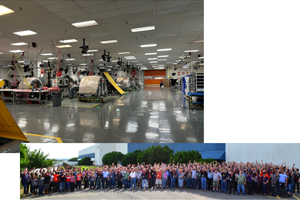Additive manufacturing and composites: An update
Additive manufacturing has only begun to tap the potential available in the composite industry.
The ISO/ASTM 52900 standard defines additive manufacturing (AM) as the process of joining materials to make parts from 3D model data, usually layer upon layer, as opposed to subtractive and formative manufacturing methodologies. AM is used to build physical models, prototypes, patterns, tooling components and production parts in plastic, metal, ceramic, glass and composite materials. AM encompasses seven distinctly different processes. Parts can be created in a layer-by-layer fashion by extruding, jetting, photo-curing, laminating or fusing materials.
AM continues to be a rapidly expanding ecosystem. In 2016, the AM industry, consisting of all AM products and services worldwide, grew 17.4% (CAGR) to US$6.063 billion. This compares to 25.9% growth in 2015 when the industry reached US$5.165 billion. The CAGR for the past four years (2013- 2016) is 28%. The CAGR over the past 28-year period is an impressive 25.9%.
This US$6.063 billion estimate of worldwide revenue includes industrial systems and desktop 3D printers (those that sell for less than US$5,000). And, it’s important to note that this estimate does not include R&D initiatives at original equipment manufacturers (OEMs) and their suppliers. They are among the principal customers of AM products and services. Also, it does not include revenue from AM parts manufactured by OEMs.
In 2016, 97 manufacturers from around the world produced and sold industrial-grade additive manufacturing systems (those that sell for US$5,000 or more). is compares to 62 manufacturers in 2015 and 49 in 2014.
In my 2010 report to CW’s readers on this subject, I noted that AM methods had begun to transition from primarily prototyping and functional modeling to the manufacture of finished production parts. Our 2009 survey of AM companies showed that AM part production represented 15.6% of their business in 2008. In 2016, this figure grew to 60.6%.
Also in 2010, I noted that AM’s impact on the composites industry was difficult to gauge, but several AM technologies offered opportunities to manufacturers. In the seven years since, we have seen additional system manufacturers offer machines that produce composite parts, with moderate adoption of them.
AM processes offer reduced costs and time associated with the development of tooling, especially for complex parts. And because multiple small parts can be built simultaneously, production efficiency is inversely proportional to part size, which makes the process very attractive for individual parts. Some organizations have discovered the use of AM to produce tooling for composite layups. I see this as an opportunity that will grow over time. I concluded in 2010 with this observation: “I see a need and opportunity for the composites and AM industries to cooperate and grow together. Both have a lot to gain by jointly solving some of the problems that we face and by offering a wider range of materials.”
Additive manufacturing continues to represent a relatively
 new and exciting frontier for composites manufacturers. Since 2010, several companies have come forward with unique and groundbreaking developments. Cincinnati Inc. (Harrison OH,
 US) co-created, with Oak Ridge National Laboratory (Oak Ridge, TN, US), the Big Area Additive Manufacturing (BAAM) system
 that offers print rates of 45-68 kg/hr. Also, it has a print envelope measured in meters rather than in millimeters, for true large-scale composites manufacturing. EnvisionTEC Inc. (Mt. Laurel, NJ, US) has developed small and mid-sized systems capable of printing to 0.03 mm resolution and can handle glass-reinforced, high-strength plastics. Markforged (Cambridge, MA, US) has introduced its Mark One, the world’s first commercial 3D printer equipped to 3D print parts with continuous strand carbon, Kevlar or glass fiber reinforcement. Similarly, Arevo Inc.(Santa Clara, CA, US) has developed additive manufacturing systems that combine continuous fiber reinforcement with thermoplastic matrices.
These and other developments are interesting, but in many ways, my concluding words from 2010, stated earlier, still apply. So much more needs to be done to fully tap the potential. In many ways, the AM industry has only begun to realize what’s possible in composites manufacturing.
To acquire a copy of the Wohlers Report 2017 (US$595, print; US$495, PDF), visit .
Related Content
The next-generation single-aisle: Implications for the composites industry
While the world continues to wait for new single-aisle program announcements from Airbus and Boeing, it’s clear composites will play a role in their fabrication. But in what ways, and what capacity?
Read MoreThe evolution, transformation of DEA from lab measurements to industrial optimization
Over the years, dielectric analysis (DEA) has evolved from a lab measurement technique to a technology that improves efficiency and quality in composites production on the shop floor.
Read MoreLaser cleaning in composites manufacturing
Laser cleaning technologies for cleaning production molds for composites offer alternatives to harsher, less-friendly methods with features like automation and higher power cleaning.
Read MoreReducing accidental separator inclusion in prepreg layup
ST Engineering MRAS discusses the importance of addressing human factors to reduce separator inclusion in bonded structures.
Read MoreRead Next
Cutting 100 pounds, certification time for the X-59 nose cone
Swift Engineering used HyperX software to remove 100 pounds from 38-foot graphite/epoxy cored nose cone for X-59 supersonic aircraft.
Read MoreNext-gen fan blades: Hybrid twin RTM, printed sensors, laser shock disassembly
MORPHO project demonstrates blade with 20% faster RTM cure cycle, uses AI-based monitoring for improved maintenance/life cycle management and proves laser shock disassembly for recycling.
Read MoreCeramic matrix composites: Faster, cheaper, higher temperature
New players proliferate, increasing CMC materials and manufacturing capacity, novel processes and automation to meet demand for higher part volumes and performance.
Read More











